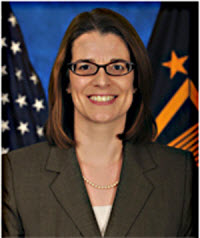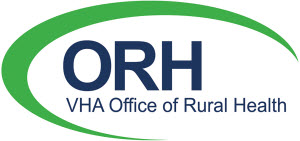Apr 28, 2015
An Interview with Gina Capra
 Gina Capra, Director of
the Veterans Health Administration's Office of Rural
Health (ORH), specializes in connecting rural veterans to
the healthcare services they need. In doing so, Capra
connects with regional Veterans in Integrated Service
Networks (VISNs), Veterans Affairs (VA) medical centers,
and national and state program offices to explore ways to
reduce the barriers to access that many rural veterans
and providers face. The Veterans Choice Program, part of
the Veterans Access, Choice, and Accountability Act of
2014, was created as a way to address access issues by
providing eligible veterans with a choice to receive
non-VA healthcare through VA-approved local providers.
The Office
of Rural Health is the lead office on rural
provisions within the Veterans Choice Act.
Gina Capra, Director of
the Veterans Health Administration's Office of Rural
Health (ORH), specializes in connecting rural veterans to
the healthcare services they need. In doing so, Capra
connects with regional Veterans in Integrated Service
Networks (VISNs), Veterans Affairs (VA) medical centers,
and national and state program offices to explore ways to
reduce the barriers to access that many rural veterans
and providers face. The Veterans Choice Program, part of
the Veterans Access, Choice, and Accountability Act of
2014, was created as a way to address access issues by
providing eligible veterans with a choice to receive
non-VA healthcare through VA-approved local providers.
The Office
of Rural Health is the lead office on rural
provisions within the Veterans Choice Act.
What inspired you to get involved with veterans and rural healthcare?
 I come from a veteran's family. My father and
grandfather were both enlisted members of the Navy and
Army, respectively. I grew up in a family where military
service is highly valued and respected. So, an
opportunity to give back in some way to veterans has
always been important to me. Healthcare access is a
social justice issue for me. I believe that all
individuals should have equal access to high quality
healthcare regardless of where they live, their
socioeconomic status, or any demographic factors. Working
at the Office
of Rural Health combines both!
I come from a veteran's family. My father and
grandfather were both enlisted members of the Navy and
Army, respectively. I grew up in a family where military
service is highly valued and respected. So, an
opportunity to give back in some way to veterans has
always been important to me. Healthcare access is a
social justice issue for me. I believe that all
individuals should have equal access to high quality
healthcare regardless of where they live, their
socioeconomic status, or any demographic factors. Working
at the Office
of Rural Health combines both!
Why do you think the Veterans Choice Program was a necessary component of the Veterans Access, Choice, and Accountability Act?
I am thrilled that the Veterans Choice Program advances the issue of healthcare access and community collaboration. Here in the Office of Rural Health, we've known for years that access to care can be a challenge for veterans in rural communities, who face long distances to VA facilities or provider shortages. We've invested significant resources in local projects that have brought care closer to home for our veterans. The Veterans Choice Program advances this work even further, by opening the door for rural community providers to partner with the VA. This partnership not only provides more resources, but also more locations from which our veterans can choose to receive their healthcare.
What are some areas of concern that you're hearing regarding the Veterans Choice Program?
I have two primary concerns on the Veterans Choice Program—building a network of local community providers and how “site of care” is defined.
First, in order for the Veterans Choice Program to be successful, it requires local community providers to partner with the VA in order to provide more local sites of care for eligible veterans. Since the implementation of the Veterans Choice Program in November 2014, the Office of Rural Health has conducted national, state, and local outreach to increase awareness for rural healthcare providers; state and national policy makers; and local program administrators. Our education and recruitment efforts will continue, and I encourage interested providers to learn more. We are eager to work with local healthcare providers to deliver the best care to our veterans.
We are eager to work with local healthcare providers to deliver the best care to our veterans.
Second, the Veterans Choice Program indicates that eligible veterans can receive care locally if they are more than 40 miles driving distance from a VA site of care. I am pleased that VA recently expanded the calculation for determining “40 miles” from “as the crow flies” to “driving distance” from a veteran's residence to a VA site of care. However, while the VA offers a variety of care sites such as medical centers and community based outpatient clinics, these sites don't always offer the necessary type of care or specialists a patient needs. So, while a veteran can reach a site within 40 miles, it might not have the type of service they need. VA and Congress are currently working together on this concern.
How can rural healthcare providers become VA-approved providers for the veterans in their community?
The VA established broad eligibility criteria for community providers and contracted with Health Net and TriWest to be “third party administrators” (TPA). The TPA is responsible for building a community provider network. To become a Veterans Choice provider, you must establish a provider agreement with the TPA. This requires an abbreviated credentialing process and a negotiation around reimbursement rates. Interested providers can get more information at 866-606-8198 or by reading the Non-VA Medical Care Program Fact Sheet for Interested Providers: Patient-Centered Community Care and Veterans Access, Choice, & Accountability Act (no longer available online).
From my perspective, the ultimate benefit is about veterans having the choice to obtain care in their local community in coordination with the VA. Of course, each facility will have to assess the pros and cons associated with facility/provider participation. The VA encourages all community providers to consider participation in the Veterans Choice Program.
How long will the Veterans Choice Program be available? Do you expect a similar program to be available long-term?
The Veterans Choice Act authority will sunset in three years or when the Veterans Choice Fund is exhausted. While I can't say what will be in place three years from now, I do know many efforts are underway to assess the delivery of care and services to veterans now and in the future.
How has the use of telehealth changed the way rural veterans access and receive care?
Telehealth has really transformed healthcare in rural communities in a variety of ways. Telehealth allows rural veterans to obtain medical care in their home and allows them to access specialty care from a smaller clinic that is close by. It also cuts down on veterans' drive time to a VA facility. Additionally, telehealth supports our medical providers' ability to deliver the best care. For example, telehealth enables local primary care providers to pull in national specialists on complicated cases, such as cancer or HIV.
A key issue with telehealth; however, is that it requires access to broadband internet service. More than half-a-million rural veterans did not have access to broadband in fiscal year 2014. The Office of Rural Health is actively involved in the White House Rural Council's effort to encourage broadband expansion into rural communities.
I understand that the VA has adapted the Project ECHO model. How has that provided support for providers and patients at rural VA clinics?
In VA, the ECHO model is known as the Specialty Care Access Network – Extension for Community Healthcare Outcomes (SCAN-ECHO). The Office of Rural Health expanded SCAN-ECHO to rural VA providers so that they could access professional training and workforce support in specialty areas. A referral to a specialist is not always necessary if the local primary care provider is able to more fully manage their patients' needs locally. The SCAN-ECHO program utilizes telehealth technology to connect primary care providers and specialists. This is yet another example of how telehealth can advance access to care for patients and support rural providers.
What is the Rural Veterans Coordination Pilot program? What is it hoping to achieve?
The purpose of the Rural Veterans Coordination Pilot is to support rural veterans and their families as they transition from military to civilian life. Five grantees were selected nationwide that serve eight states. These grant recipients are coordinating and delivering support services to rural veterans based on a locally-tailored approach. In the first quarter alone, more than 100 community partnerships were established by our grantees. The grantees are projected to support more than 25,000 rural veterans over the two year pilot period.
Are there other innovations or promising practices for serving rural veterans that you'd like to mention?
One of the things I'm most excited about is our rural promising practices. We initiated promising practices to identify and disseminate models of care that improve the health and well-being of rural veterans. Our hope is that we can help spread proven solutions that help rural healthcare delivery. For example, to counter the lack of infectious disease specialists in rural communities, our “Human Immunodeficiency Virus (HIV) virtual team” promising practice provides a model for HIV treatment and provider training via telehealth. Another promising practice provides an at-home approach to cardiac rehabilitation for veterans following a heart attack. This model reduces drive times that often are more than two hours round-trip per visit in rural communities.
To increase the adoption of these promising practices at VA facilities across the country, the Office of Rural Health supports a peer mentoring program that enables providers to learn from the experts who created the promising practice, including open access to all related policies, documents, lessons learned and patient education materials. It's a type of technical assistance or “open source” medical learning.
Do you have any final thoughts to share with our readers?
Simply put, the VA's Office of Rural Health works to see that America's veterans thrive in rural communities. We can't do this alone. We count on all individuals and communities to rally around our rural veterans and their families. Veterans have earned and deserve all of our support.
Learn more about VA's efforts to increase rural veterans' access to care and services by visiting the Office of Rural Health website or watching this 3-minute video:
Opinions expressed are those of the interviewee and do not necessarily reflect the views of the Rural Health Information Hub.
